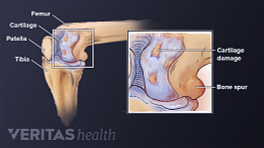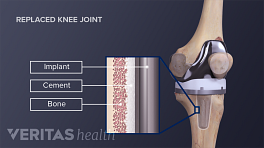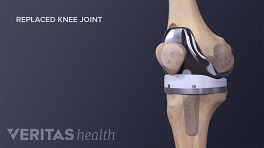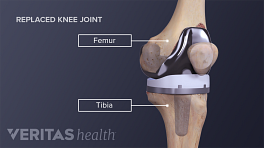A patient’s recovery and rehabilitation plan is crucial to the overall success of knee replacement surgery. A recovery and rehabilitation plan can help the patient:
- Leave the hospital sooner
- Regain knee strength and range of motion more quickly
- Resume independent living sooner
- Avoid potential complications
Typically, knee replacement patients are able to leave the hospital within 1 to 5 days (often 2 or 3), and they can take care of themselves and resume most activities 6 weeks after surgery. The majority of patients are 90% recovered after 3 months, though it can take 6 months or longer before they are 100% recovered.
See Knee Surgery for Arthritis
Some knee replacement patients do not follow the typical recovery timeline. For example:
- Patients who did knee-strengthening exercises in preparation for surgery sometimes recover more quickly.
- Patients who are older, smoke, or have other medical conditions may take longer to heal.
Deviation from the “typical” recovery timeline cannot always be predicted, but these differences are usually okay as long as the patient, doctor, and physical therapist, continue to work together towards a full recovery.
In This Article:
- What to Expect After Knee Replacement
- “When Can I…?” Answers for Knee Replacement Patients
- Post-Surgical Knee Replacement Precautions and Tips
- Knee Replacement Surgery Rehabilitation Exercises
The First 24 Hours After Knee Replacement Surgery
After surgery, the patient will wake up from anesthesia and begin to regain feeling in his or her legs. Doctors will pre-emptively treat pain using a combination of pain-relief methods that complement each other and minimize side effects, an approach that is called multimodal analgesia.
Read more about multi-modal analgesia and Managing the Pain of Joint Replacement.
Within 24 hours, if pain is under control, the patient may be asked to stand up and take a few steps with the aid of a physical therapist and/or a walker. Patients who get up and bear some weight (with assistance) on their new knees soon after surgery tend to recover more quickly than patients who do not.
Continuous Passive Motion (CPM) Machines
Some doctors prescribe continuous passive motion (CPM) machines after surgery. A CPM machine slowly moves the affected leg, causing it to repeatedly straighten and bend, while the patient is lying on his or her back. A patient may use a CPM machine for up to 8 hours a day, in between sleeping and physical therapy.
Evidence suggests CPM machines help patients regain range of motion more quickly, 1 Harvey LA, Brosseau L, Herbert RD. Continuous passive motion following total knee arthroplasty in people with arthritis. Cochrane Database Syst Rev. 2014 Feb 6;2:CD004260. doi: 10.1002/14651858.CD004260.pub3. Review. PubMed PMID: 24500904. which can facilitate a faster hospital discharge. Some patients are also prescribed CPM machines for temporary use at home after discharge.
Not all insurance companies cover CPM machines and, while they do help patients regain flexibility sooner, there is no definitive evidence that the CPM use affects risk of DVT, long-term knee range of motion, or knee function. 2 Canale ST and Beaty JH, eds. Campbell’s Operative Orthopaedics. Vol 1. 12th ed. Philadelphia, PA: Elsevier Mosby; 2013.
How Much Weight Can Be Put On the New Knee?
Knee replacement patients are given weight-bearing guidelines to follow in the hospital and at home. Exactly how much pressure the new knee can initially support will depend on factors such as:
- The type of surgery preformed (e.g. total replacement vs. one-sided knee replacement)
- The type of prostheses and how it is fixated to the natural bone
- The condition of the patient’s natural bone
Over time, patients will be asked to put incrementally more weight on the new knee.
When Can a Knee Replacement Patient Leave the Hospital?
Most knee replacement patients will be discharged once pain is under control and they are able to:
- Get in and out of bed and walk short distances (typically 150 to 300 feet) with the aid of a walker or crutches
- Get into and out of bed and get up and down stairs
- Bend the knee 90 degrees
- Follow precautions to avoid injuring the new knee
Discharge criteria can vary depending on the patient and the hospital’s policy. For example, some hospitals may require the patient to only bend the knee 80 degrees.
Some patients meet the criteria for discharge after just one or two days. People who have two knees replaced at the same time, certain pre-existing medical conditions, uncontrolled pain, or general weakness may be kept in the hospital longer.
See Facts and Considerations for Total Knee Replacement
Discharge to a rehabilitation facility
Patients who live in multi-level homes, who do not have live-in caregivers, or who face other rehabilitation challenges may be discharged to a short-term care facility that provides health care and physical and occupational therapy. These stays may be covered by insurance, depending on the policy and patient circumstances.
- 1 Harvey LA, Brosseau L, Herbert RD. Continuous passive motion following total knee arthroplasty in people with arthritis. Cochrane Database Syst Rev. 2014 Feb 6;2:CD004260. doi: 10.1002/14651858.CD004260.pub3. Review. PubMed PMID: 24500904.
- 2 Canale ST and Beaty JH, eds. Campbell’s Operative Orthopaedics. Vol 1. 12th ed. Philadelphia, PA: Elsevier Mosby; 2013.











